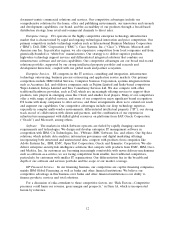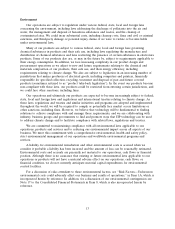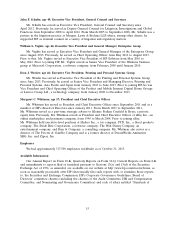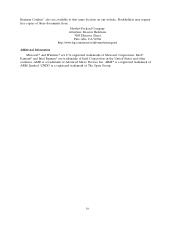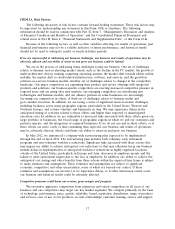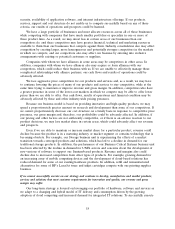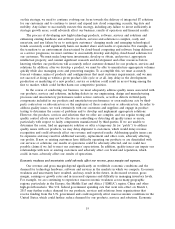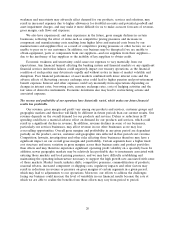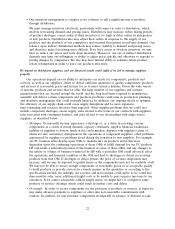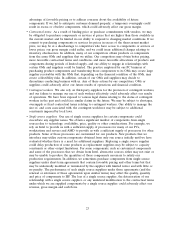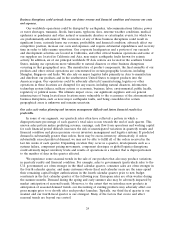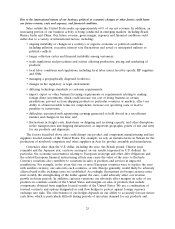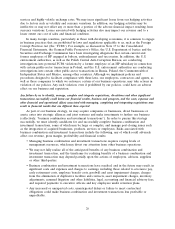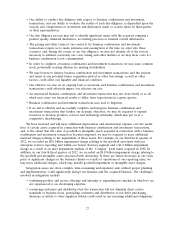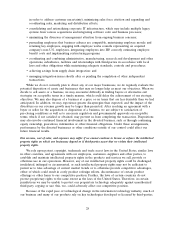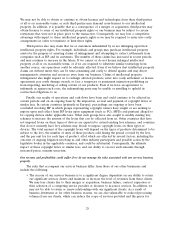HP 2013 Annual Report Download - page 29
Download and view the complete annual report
Please find page 29 of the 2013 HP annual report below. You can navigate through the pages in the report by either clicking on the pages listed below, or by using the keyword search tool below to find specific information within the annual report.If we do not effectively manage our product and services transitions, our revenue, gross margins and
profitability may suffer.
Many of the markets in which we compete are characterized by rapid technological advances in
hardware performance and software features and functionality, frequent introduction of new products,
short product life cycles, and continual improvement in product price characteristics relative to product
performance. To maintain our competitive position in these markets, we must successfully develop and
introduce new products and services. Among the risks associated with the introduction of new products
and services are: delays in development or manufacturing, variations in costs, delays in customer
purchases or reductions in the price of existing products in anticipation of new introductions, difficulty
in predicting customer demand for the new offerings and challenges of effectively managing inventory
levels so that they are in line with anticipated demand; risks associated with new products meeting
customer qualifications and customer evaluation of new products; and the risk that new products may
have quality or other defects or may not be supported adequately by application software. If we do not
make an effective transition from existing products and services to future offerings, our revenue and
gross margins may decline and our profitability may be harmed.
Our revenue and gross margin also may suffer as a result of the timing of product or service
introductions by our suppliers and competitors. This is especially challenging when a product has a
short life cycle or a competitor introduces a new product just before our own product introduction.
Furthermore, sales of our new products and services may replace sales or result in discounting of some
of our current offerings, offsetting the benefit of even a successful introduction. There also may be
overlaps in our current products and services and portfolios we have acquired through mergers and
acquisitions that we must manage. In addition, it may be difficult to ensure performance of new
customer contracts in accordance with our revenue, margin and cost estimates and to achieve
operational efficiencies embedded in our estimates. Given the competitive nature of our industry, if any
of these risks materializes, future demand for our products and services and our results of operations
may suffer.
If we fail to manage the distribution of our products and services properly, our revenue, gross margins and
profitability could suffer.
We use a variety of distribution methods to sell our products and services, including third-party
resellers and distributors and both direct and indirect sales to enterprise accounts and consumers.
Successfully managing the interaction of our direct and indirect channel efforts to reach various
potential customer segments for our products and services is a complex process. Moreover, since each
distribution method has distinct risks and gross margins, our failure to implement the most
advantageous balance in the delivery model for our products and services could adversely affect our
revenue and gross margins and therefore our profitability. Other distribution risks are described below.
• Our financial results could be materially adversely affected due to channel conflicts or if the
financial conditions of our channel partners were to weaken.
Our results of operations may be adversely affected by any conflicts that might arise between
our various sales channels, the loss or deterioration of any alliance or distribution arrangement
or the loss of retail shelf space. Moreover, some of our wholesale and retail distributors may
have insufficient financial resources and may not be able to withstand changes in business
conditions, including economic weakness and industry consolidation. Many of our significant
distributors operate on narrow product margins and have been negatively affected by business
pressures. Considerable trade receivables that are not covered by collateral or credit insurance
are outstanding with our distribution and retail channel partners. Revenue from indirect sales
could suffer, and we could experience disruptions in distribution, if our distributors’ financial
conditions, abilities to borrow funds in the credit markets or operations weaken.
21



